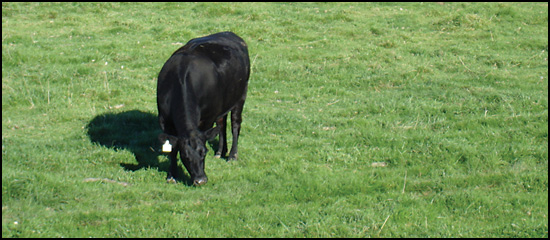
Heat and Fescue:
Bad Combination for Heifers
It is hard enough breeding heifers under the best of conditions, so when heat stress and endophyte-infected fescue are added to the mix, reproductive systems, pregnancy rates, and the long-term bottom line are all bound to suffer.
With reproductive performance as the most important economic trait in a beef cow herd, researchers at the University of Missouri (MU), the University of Arkansas–Fayetteville, and the U.S. Department of Agriculture (USDA) Agricultural Research Service (ARS) have identified direct links between high ambient temperatures, the consumption of toxic fescue and impeded ovarian development in heifers. Read more.
What’s Inside …
The May Angus Beef Bulletin EXTRA features several valuable articles, including specific sections devoted to management, marketing, and health and nutrition information. Select from the tabs above to access this month’s entire information-packed edition, a portion of which includes the following:
• Special Section — Focus on Reproduction
• Calf-Fed or Yearling Production System?
• Repro Tracks: Contract recipient herds for embryo transfer
• Test Bulls for Breeding Soundness
• Anthrax Vaccinations Recommended Before Turning Cows to Pasture
• In the Cattle Markets: Bullish corn report not so friendly for cattle feeders
• Feeding and Marketing Cull Cows
• Market Advisor: Will H1N1 virus affect beef and cattle prices?
Calf-Working Time: Proper Injection Sites
The month of May is traditionally the time when “spring round-ups” take place. This is the time that large- and small-scale cow-calf operations schedule the “working” of calves. As the majority of the calves reach their second month of life, it is time to castrate the male calves and immunize all of the calves to protect them against blackleg and respiratory diseases.
Correct administration of any injection is a critical control point in beef production and animal health. Cow-calf producers should make certain that their family members, and other hired labor are sufficiently trained as to the proper location of the injections before the spring calf-working begins. Read more.
News Briefs …
• How Much is Pasture Renting For?
• TB Case Identified on Indiana Cervid Farm
• $60M Designated for Rural Community Facilities
• BSE Case Confirmed in Alberta
• President Obama Pushes to Expand Biofuels
What Cattlemen Want …
We asked Angus Beef Bulletin Extra subscribers what they wanted from their seedstock suppliers. Here’s what a few of them had to say. Read more.

Ty Groshans
Association Perspective
Let’s talk marketing
Marketing is a series of activities used to find potential buyers, motivate them to buy, get them to buy your product and then have them return to purchase again. Marketing is how you define your product, promote your product, distribute your product, and maintain a relationship with your customers.
Marketing is defined by the American Marketing Association (AMA) as the activity; set of institutions; and processes for creating, communicating, delivering and exchanging offerings that have value for customers, clients, partners, and society at large. The term developed from the original meaning, which referred literally to going to market, as in shopping, or going to a market to buy or sell goods or services.
It’s time to get creative! By creative I am referring to the programs that are available to producers, seeking out marketing channels, advertising, utilizing breed associations and communicating with buyers. Whether it is age- and source-verification, non-hormone-treated cattle (NHTC) or the many vaccination/preconditioning programs available, enroll your calves in the ‘right’ program for your operation and set yourself up for success! Communicating with the customer/buyer is the key element to producing a product that is in demand. Who is your customer and what product/service do they want? How are you setting yourself apart from everyone else? Are you thinking about marketing your feeder calves year-round or just the week before you sell them?
“Clients want either the best or the least-expensive; there is no in between.”
— John DiJulius, in the book Secret Service
Association Update
The American Angus Association has recently announced the following updates and notices:
• Important Update on Neuropathic Hydrocephalus (NH)
On Wednesday, April 29, 2009, the Board of Directors of the American Angus Association conducted a special meeting by phone. The purpose of the meeting was to discuss the ongoing work of a Special Committee appointed by the Board to examine the Association's recently-enacted genetic defect policy and that policy's applicability to Neuropathic Hydrocephalus (NH). Click here.
• Association Web Sites to go Down During Computer System Update
The American Angus Association will be updating its computer system during the weekend of May 29 through June 1. Beginning Friday afternoon (May 29), several Association web sites will be unavailable for use. In particular, the AAA Login web site will be down the entire weekend.
Other web sites will have intermittent access available during this time. This notice includes the web sites for American Angus Association, National Junior Angus Association, Angus Productions Inc., and Angus Foundation.
Special note: National Junior Angus Show — The entry deadline and ownership deadline for the National Junior Angus Show is June 1, 2009 (postmark date). Please plan accordingly as online show entries will not be available after 4:30 p.m. CDT on May 29 due to computer system upgrades. All transfers need to be submitted prior to May 29, 2009, to ensure the work is completed. Thank you for your patience during this time of transition, and we apologize for any inconvenience.
Cutting Excess Spring Pasture for Hay
Extra rain produces extra grass, something many of us didn’t count on this spring. As pastures grow faster than cattle can eat, finding ways to use this extra grass efficiently can be like money in the bank.
The most obvious way to conserve extra growth is by cutting hay from parts of the pasture. Normally I try to avoid extra hay cutting, but if you have the equipment and more pasture than you can use this spring, and some time, cutting hay for use later in summer or winter when pasture becomes scarce is a good option. Read more.
University Offers Producers Resources
for Battling High Input Costs
From better storing grain byproducts to reducing mineral costs, “Profit Tips” on the University of Nebraska-Lincoln Extension’s Beef web site can help the cattle producers save money.
Cattle producers are facing economic challenges due to high input costs, such as fuel, land, fertilizer and especially feed. Feed costs represent a major part of beef cattle production expenses.
“The high cost of feed grains is putting cow-calf and feedlot profits under severe economic pressures,” said Judson Vasconcelos, feedlot nutrition/management specialist at UNL’s Panhandle Research and Extension Center at Scottsbluff.
The UNL Extension initiative, “Surviving High Input Costs,” targets feedlot and cow-calf producers. Read more.
Feeding & Feedstuffs Web Site Available
The annual cost to feed the herd these days can be mind-boggling. Increasing pasture rents, competition for feedstuffs and increasing input costs certainly complicate efforts to control the feed bill.
Yet experts agree, nutrition is not an area in which cattlemen can afford to skimp. With this in mind, Angus Productions Inc. (API) has created the Feeding & Feedstuffs site to provide a portal to information to help you efficiently meet the nutritional needs of your herd. Click here to access the site.







